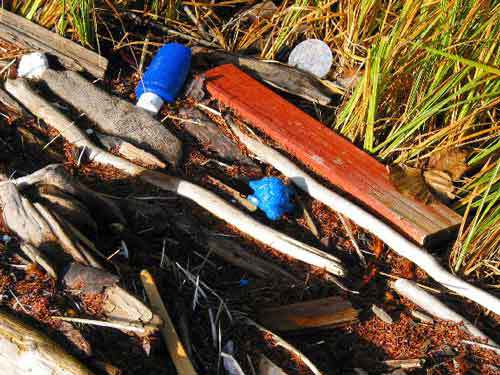

Accidental and intentional plastic rides the ocean
Twenty-eight years after scientists spilled hundreds of plastic discs on the ice of the Beaufort Sea to determine ocean currents, another one has come home to roost at the Geophysical Institute at the University of Alaska Fairbanks.
In summer 2007, graduate student Nathan Coutsoubos of UAF¹s Resilience and Adaptation Program found a yellow plastic disk on the tundra in Barrow, just 60 feet from a salt-water lagoon. He picked up the disc and saw a printed message: "One Dollar Reward on Return of Serial Number with Date Found, Location, Your Name and Address to Geophysical Institute, Univ. of Alaska, Fairbanks."
Coutsoubos, who studies shorebirds on the North Slope, brought the disc back to Fairbanks, where he will return it to Roberta Greenlee of the Geophysical Institute's Business Office. Greenlee has handed out these dollars for years, but not since 1998, when two brothers in Scotland returned a disc they had found in the rocks there.
In 1979, scientists scattered 1,500 of the seven-inch discs on the sea ice around Prudhoe Bay to see how oil spilled there might drift. Researchers involved with the project wrote up the final report long ago after people found hundreds of discs in North Slope villages and collected their dollars,
but a few of the discs endure.
The 1979 experiment wasn't the first time scientists dropped things in Alaska waters that they hoped others would find. From 1956 to 1959, Canadian scientists stuffed messages into 19,000 12-ounce brown beer bottles and set them adrift in the Gulf of Alaska. In the notes, they asked the finders to tell them where they picked up the bottles, so they could better understand ocean currents. The last published report of a message-in-a-bottle find was in 1972.
Today, scientists use floating buoys, computer models, satellites, and other high-tech methods to learn more about ocean currents, but researchers still get a lot of information from objects floating on the ocean, many of them as a result of shipping accidents.
Dean Orbison of Sitka and his son Tyler have gained a bit of fame among beachcombers for their collection of 130 floating plastic turtles, ducks, beavers, and frogs that are a subset of 28,800 toys that fell off a ship in
the North Pacific in January 1992.
According to Curtis Ebbesmeyer, an oceanographer from Seattle, the Orbison's bath toys were caught up in the Pacific Subarctic Gyre, a counterclockwise circulation of water that extends from the southern coast of Alaska to Kamchatka in Russia. Objects floating in the gyre make complete tours of the North Pacific about every three years, Ebbesmeyer wrote in a recent article in EOS, a publication of the American Geophysical Union.
Dean Orbison said his records of when he picked up the bath toys, confirmed by his boating log entries, support the theory that the toys are riding the Subarctic Gyre. He and his son Tyler have found one beaver and one turtle so far in 2007, a year Ebbesmeyer said the gyre might again circulate toys from
the 1992 container spill to Southeast Alaska beaches.
Dean and Tyler do much of their beachcombing based out of their 38-foot boat, "The Prost." Their favorite items to find are glass floats formerly used on nets by Japanese fishermen, which are getting more rare, unlike some plastic items.
"The single biggest item we've found in the last five years is plastic water bottles," Orbison said.
Plastic is all over the world's oceans. A researcher in Hawaii in 2000 picked apart the regurgitated pellets of 144 albatrosses and found plastic in every single one. Sun breaks plastic down to a small extent, but the floating toys and other items will never completely disappear.
"Ultimately, the toys will return to dust," wrote Ebbesmeyer in his Beachcombers Alert! newsletter, "joining the scum of plastic powder (that) rides the global ocean."






